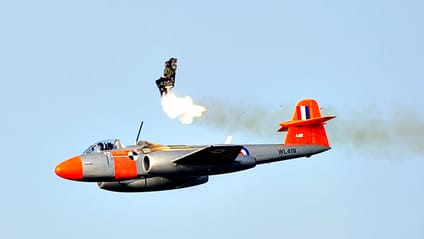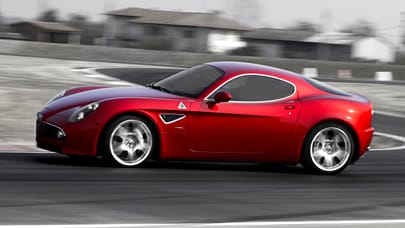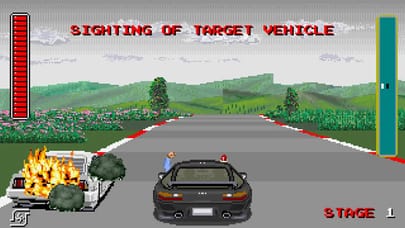
Ejector seats and tanks: how the world's toughest watches are tested
Here's how watchmakers make sure their creations can survive almost anything

Ejected from a plane...

When fired from an ejector seat, a fighter pilot experiences acceleration of up to 30g, albeit for the briefest of periods. As does his or her wrist, assuming it's not still attached to the finger jammed into the ejector mechanism as the rest of the pilot's body pings merrily into the void.
So the watch upon that wrist must also be able to withstand the force of the ejection - because, let's be honest, there's nothing worse than having no idea what time it is as you're catapulting through open sky, 20,000 feet above sea level, praying your emergency parachute will activate as you watch the remains of your bird plunging fierily towards the ground beneath.
Enter watchmaker Bremont, and Martin-Baker, the British aviation company that supplies 70 per cent of the world's air forces with fighter-jet ejector seats. The two companies hooked up in 2007 with the aim of creating a watch that would survive not only the forces of an ejection, but also the same extreme tests that Martin-Baker seats must undergo to ensure decades of reliable service on the front line.
"We have to put the seat through one of the most comprehensive qualification programmes for a product," says Martin-Baker vice president Andrew Martin. "Every possible scenario you could come up with."
Advertisement - Page continues below
It's a cheery set of exams that includes being frozen at -40°C for 24 hours, being raised 100,000 feet above sea level before being dropped back to earth, and a juddery, time-compressed simulation of every vibration experienced during an ejector seat's 30-year life in the air. If Martin-Baker's seats survive it, so too must Bremont's watch.
The knurled ejector seats provided visual inspiration for the Bremont team, too, with the yellow-and-black loop at the end of the second hand referencing the design of the chair's ejection pull handle, if not its explosive reaction to a gentle tickle.

The first fruit of the two companies' collaboration was 2009's limited-edition MBI, offered only to pilots who have undergone a ‘live' ejection in a Martin-Baker seat. That's a list including, we're told, US congressmen and senators in addition to grizzled air aces. Oh, and one unnamed Hollywood star, who's never experienced an ejection, but persuaded an ejectee to buy one on his behalf.
But Bremont's latest Martin-Baker collaboration, the MBIII, is available to civvies too. If it can survive a full-bore ejection, it'll definitely keep ticking when you accidentally flick the ‘height adjust' lever on your office chair.
Advertisement - Page continues belowDropped to the bottom of the ocean...

In March 2012, Hollywood director James Cameron - he of Terminator, Titanic and Avatar fame - descended to the base of the Pacific's Mariana Trench in his purpose-built Deepsea Challenger submarine. It was only the second-ever manned journey to the bottom of the trench, a journey dramatised in the director's recent 3D cinema release.
The base of the Mariana Trench lurks seven miles below sea level, the deepest spot on Earth. Cameron dived three times deeper than the wreck of the Titanic lies below the surface, going 2,000 metres further below the surface of the sea than Mount Everest reaches above it.
And where Cameron went, so did Rolex's experimental Deepsea watch. Not on Cameron's wrist, protected within a pressurised cocoon, but strapped to the outside of the hyper-reinforced sub. This meant it was subjected to the most extraordinary forces our planet can serve up, a crushing 1,097 bars of pressure (or 15,917psi in tyre-inflating money).

The Rolex teams drew up a super-resilient watch, its joins engineered to a freakishly high tolerance to ensure there was not even a micron-wide gap into which water could squeeze. Watch assembled, to ensure the Deepsea would survive the dive, Rolex had to subject it to even more abuse than it would endure in the Mariana: no less than 1,500 bars of pressure to ensure the 25 per cent safety margin allowing it to be classified as a 12,000-metre diver's watch.
1,500 bar is the equivalent of 17 tonnes pushing down on the watch, or about seven Rolls-Royce Phantoms balanced on the caseback. Rolex didn't have seven Phantoms to hand, but it did have a hyperbaric tank, capable of testing watches to the equivalent of a 15,000-metre depth.
The Deepsea survived its training, but sending it to the base of the Mariana represented, quite literally, a voyage into the unknown. But, as the sub returned to the surface of the Pacific on 26 March 2012, the Rolex emerged unscathed and ticking happily. As, thankfully, did Cameron.
Run over by a tank...

You'll probably know Victorinox for its collection of Swiss Army knives, multifunctional tools that have, for over a century, been helping officers in the Swiss Army conduct important military duties like opening bottles of wine, picking raspberry seeds from their teeth and removing stones from their horses' hooves.
So when Victorinox set out to build the most indestructible watch on the planet, it called in its military contacts. Specifically, it called the Swiss Army's tank regiment and said: "Gents, you know that 64-tonne beast you've got parked round the back? Could you bring it over? We've got a watch that needs a lesson learning."
With a solidified crossbar and an elevated bezel protecting the crown and crystal, the watch - christened Inox - survived its ordeal beneath the tank's tracks. Unfortunately Victorinox hasn't released pictures of the actual event, or told us what type of tank was used. The German-made Leopard 2 weighs just under 65 tonnes and many were bought by the Swiss Army in the late Eighties, so it's the most likely contender. But until we see proof, we'll have to take their word for it...

Either way, the tank test wasn't the end of the watch's torture-chamber ordeal. Following its light flattening, we're told it was doused in insecticides, frozen to -51°C, cooked to 71°C, blasted with sand and, in unquestionably the toughest test of the lot, subjected to two hours in a washing machine. Oh, and it was also run over by a fire engine, as you can see above.
"There were no norms existing for testing the Inox, so we had to create them," says Victorinox CEO Alexander Bennouna. "There's no [other] watch that could withstand all the tests the Inox withstood..."
Advertisement - Page continues below
Trending this week
- Car Review
BMW 1 Series
- Top Gear's Top 9
Nine dreadful bits of 'homeware' made by carmakers







